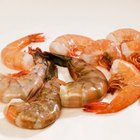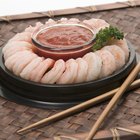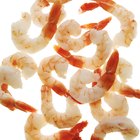
Jupiterimages/Photos.com/Getty Images
Prawns and shrimp are two large families of closely-related crustaceans, shellfish with jointed shells that permit active motion. Like crabs and lobsters, they are part of a group referred to as decapods because they have 10 legs. Although there are differences between shrimp and prawns, the terms are used interchangeably in most of the world.
Physiological Differences
Shrimp and prawns are classed as two separate families: Shrimp are classed as Caridea, and prawns belong to the Penaeidae. Each family contains hundreds of individual species scattered throughout the world's waters. There are subtle physical differences between them. Prawns' legs are all the same length, but shrimp tend to have one pair longer than the others. Also, the first three pair of prawn legs have small claws or pincers on them, but shrimp only have them on the first two pair of legs. They reproduce differently as well, with prawns releasing clouds of eggs and shrimp incubating eggs on the female's body.
Common Usage
In practice, the terms shrimp and prawn are applied without regard to marine biology. American fishmongers usually differentiate shrimp and prawns by size, with smaller specimens sold as shrimp and larger ones as prawns. Even this is not consistent, and the same shellfish might be sold in neighboring markets as tiger prawns or tiger shrimp. For culinary purposes, shrimp and prawns are both tasty and can be cooked in the same ways, so it's more important to find a brand or supplier that provides you a consistently good product.
Tiger Prawns
Tiger prawns are one of the most widely sold species. Their shells, as the name suggests, are banded with black stripes. These prawns are imported from Asia, where high-volume aquaculture operations turn out millions of pounds of these tasty shellfish. Thailand is the largest producer and is the source of most tiger prawns sold in America. These will vary widely in quality, depending on the aquaculture operator. The best tiger prawns are sweet in flavor and firm in texture, but they can also be mushy and unpleasant. Canvass your local fishmongers for recommendations before buying in quantity.
Domestic Shrimp and Prawns
Some consumers have reservations about imported Asian shrimp, because of concerns over pollution, sustainable practices and safe food handling. For those who love seafood but would prefer to buy a domestic product, there are several shrimp fisheries in the U.S. There are commercial harvests of wild shrimp on both coasts, and shrimp are widely farmed across the country. Monterey Bay Aquarium's Seafood Watch program considers these farms to be sustainably operated, because they are in areas where the shrimp cannot displace native species if they escape. Both farmed and wild-caught American shrimp earn their "Best Choice" rating.
Related Articles

Precautions With Fully Cooked Frozen ...

Jumbo Shrimp Nutritional Facts

How Long Can Shrimp Be Refrigerated?

How to Cook Frozen Shrimps That Still ...

How to Make Breaded Shrimp With Corn ...

What Is the Dark Line on a Boiled ...

How to Thaw Frozen Cooked Shrimp Quickly

How to Cook Shrimp in Beer

All You Can Eat Seafood Restaurants in ...

Are Farm Raised Mussels & Clams Healthy ...

How to Cook Lightning Whelks

How to Use a Shrimp Deveining Tool

List of Foods Containing Shellfish

How to Boil Conch in the Shell

How to Cook a Turbot Fillet

How to Cook Frozen Jumbo Butterfly ...

Can You Cook Shrimp With the Head On?

How to Cook Large Prawns

How to Cook Prawns in a Oven

How to Cook Blue Crab
References
Writer Bio
Fred Decker is a trained chef and prolific freelance writer. In previous careers, he sold insurance and mutual funds, and was a longtime retailer. He was educated at Memorial University of Newfoundland and the Northern Alberta Institute of Technology. His articles have appeared on numerous home and garden sites including GoneOutdoors, TheNest and eHow.
Photo Credits
Jupiterimages/Photos.com/Getty Images